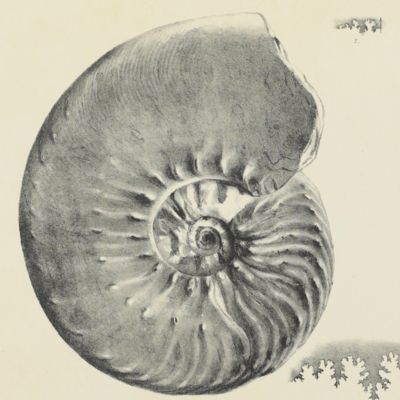Stoliczka, F.
Palaeontologia Indica, being figures and descriptions of the organic remains procured during the progress of the geological survey of India. Vol. III. 1. The fossil Cephalopoda of the Cretaceous rocks of Southern India (Ammonitidae).
Calcutta, Geological Survey Office, 1864. Folio (37.0 x 25.1 cm). Original front wrapper (acting as title page). 16 pp.; six lithographed plates. Early 20th-century green buckram. Spine with gilt title. Green endpapers.
A very early and very uncommon work on the rich ammonite faunas of India, published in the Memoirs of the Geological Survey of India with the descriptions and fine illustrations of many new and poorly known species, usually being quite well preserved. The author is the Moravian zoologist and palaeontologist Ferdinand Stoliczka (Czech Stolička (1838-1874). "Stoliczka studied geology and palaeontology at Prague and the University of Vienna under Professor Eduard Suess and Dr Rudolf Hoernes. ... In 1862 Stoliczka joined the Geological Survey of India (GSI) under the British Government in India after being recruited by Dr Thomas Oldham (1816-1878). In Calcutta he was assigned the job of documenting the Cretaceous fossils of southern India and published them in the Palaeontologia Indica, along with William Thomas Blanford. By May 1873 this work was completed with four volumes totalling nearly 1500 quarto size pages with 178 plates" (Wikipedia). This work was published as part of a series on fossil cephalopods, but also as a stand-alone, hence it contains double pagination. Provenance: a small stamp of the Yale palaeontologist Othniel Charles Marsh (1831-1899), and one of Yale University Museum, on the front wrapper, and two of the University of Georgia on the front pastedown. "Marsh is also known for the so-called 'Bone Wars' waged against Edward Drinker Cope. The two men were fiercely competitive, discovering and documenting more than 120 new species of dinosaurs between them ... The two began to develop a rivalry when Marsh allegedly pointed out that Cope had placed the skull of Elasmosaurus at the end of its tail. Cope attempted to buy back the papers containing his flawed reconstruction, but Joseph Leidy exposed his cover-up at a meeting of the Academy of Natural Sciences. This rivalry went on throughout their lives. Marsh eventually 'won' the Bone Wars by finding 80 new species of dinosaur, while Cope found 56. Cope did not take this lightly, and the two debated each other in scientific journals for many years to come" (Wikipedia). An old repair to the last plate, otherwise a very good, complete copy. Complete copies are rare. Not in Nissen ZBI, who only listed the later parts on gastropods and bivalves.




